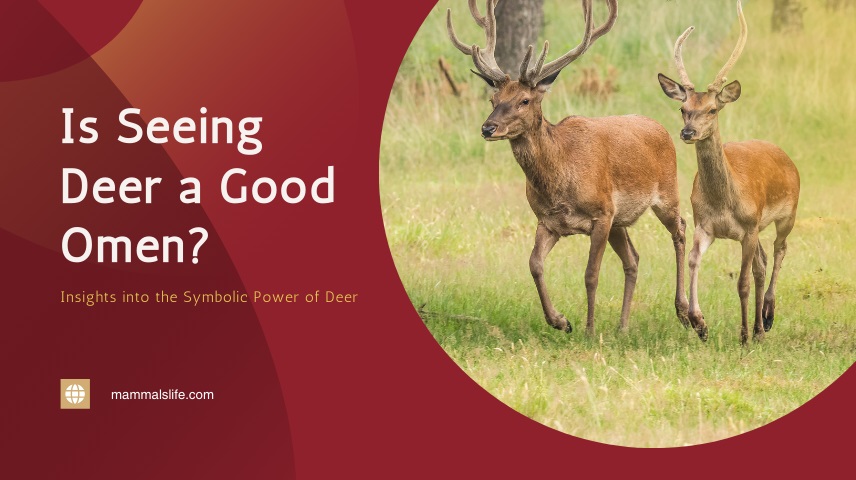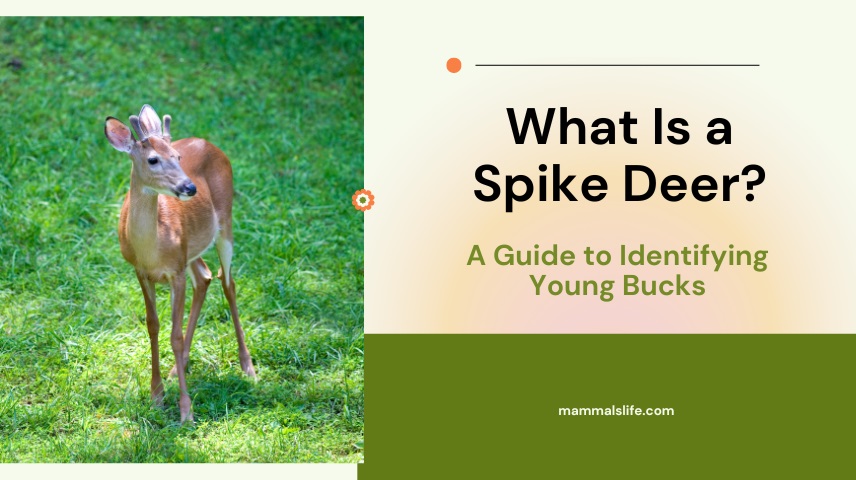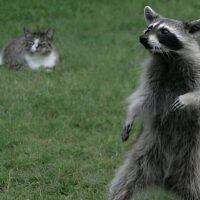Last Updated on February 22, 2025 by Mammals Life
Deer can see a green light, but not as vividly as humans. Their vision is more adapted to blue and ultraviolet light.
Understanding how deer perceive different colors helps hunters and wildlife enthusiasts. Deer have dichromatic vision, meaning they see fewer colors than humans. They can detect blue and ultraviolet light more effectively. Green and red colors appear muted to them. This knowledge can inform decisions regarding clothing, equipment, and lighting when interacting with deer.
For example, wearing green or red might make you less noticeable. Similarly, using blue lights can attract their attention. This insight into deer vision enhances both wildlife observation and hunting strategies, promoting better outcomes and respectful wildlife interactions.
Can Deer See Green Light?
Deer have dichromatic vision, meaning they can only perceive two primary colors—blue and green. While they can see green light, their vision isn’t as sharp as humans in distinguishing it. Green light may not stand out to deer as brightly as it does to us, making it less alarming for them in certain situations.
Hunters sometimes use green light because it doesn’t spook deer as much as white light does. However, it’s important to note that deer are more sensitive to blue wavelengths and have better night vision, so their reaction to different lighting can vary depending on the context.
Deer Color Vision
Many wonder if deer can see green light. Deer vision is unique and differs from humans. Understanding their vision helps in wildlife observation and hunting.
Anatomy Of Deer Eyes
Deer eyes have a large lens and a wide field of view. This allows them to detect movement easily.
| Eye Feature | Function |
|---|---|
| Large Lens | Gathers more light |
| Wide Field of View | Detects movement |
Another key feature is the tapetum lucidum. This layer behind the retina improves night vision by reflecting light through the retina.
Read More – What Do You Call a Deer With No Eyes?
Deer Color Perception
Deer have dichromatic vision, meaning they see two primary colors. They can see blue and green shades but struggle with reds and oranges.
- Blue: Clear and bright
- Green: Visible, but not as bright as blue
- Red: Hard to distinguish
- Orange: Blends with green and brown
This means deer can see green light but not as vividly as blue. Understanding these basics helps in choosing the right camouflage and gear.
Deer Vision Color Spectrum
Deer have dichromatic vision, meaning they can perceive only two primary colors: blue and green. This limited color spectrum allows them to detect some contrasts but prevents them from seeing the full range of colors that humans can. They are unable to distinguish reds, oranges, and other warm hues effectively, which is why bright orange hunting gear doesn’t stand out to them.
Deer are highly sensitive to blue and ultraviolet light, giving them an advantage in low-light conditions such as dawn and dusk. This sensitivity helps them navigate their surroundings and detect predators, even when visibility for humans is limited.
The Science Of Color Vision
Understanding how deer see colors is fascinating. It involves exploring their unique vision system. Let’s dive into the science behind color vision in animals.
How Animals See Colors
Animals perceive colors differently from humans. Their eyes contain specialized cells called cones. These cones detect different wavelengths of light.
Deer have two types of cones. They see blue and green light. They struggle with red and orange. This makes their color vision distinct.
Some animals, like birds, see more colors. They have more types of cones. This allows them to see ultraviolet light.
Read More – Can Deer See Red Light?
Comparison With Human Vision
Humans have three types of cones. We see red, green, and blue. This gives us a wide range of color vision.
Deer, with their two cones, see fewer colors. They are more sensitive to blue and green. This makes them different from us.
Below is a comparison table:
| Feature | Deer Vision | Human Vision |
|---|---|---|
| Number of Cones | 2 | 3 |
| Colors Seen | Blue, Green | Red, Green, Blue |
| Light Sensitivity | High in Low Light | Moderate |
Deer see well in low light. Their eyes are designed for this. Humans see better in bright light.
Understanding these differences helps us. It reveals how deer perceive their environment. This knowledge is valuable for wildlife enthusiasts.
Green Light Visibility
Can deer see green light? Hunters and wildlife enthusiasts often ask this question. Understanding how deer see helps in better wildlife management. Let’s explore how deer respond to green light.
Wavelengths And Green Light
Light is made up of different wavelengths. Each color has a specific wavelength. Green light ranges from 495 to 570 nanometers. This range falls in the middle of the visible spectrum. Humans see green light very well. But what about deer?
| Color | Wavelength (nm) |
|---|---|
| Violet | 380-450 |
| Blue | 450-495 |
| Green | 495-570 |
| Yellow | 570-590 |
| Orange | 590-620 |
| Red | 620-750 |
Deer’s Sensitivity To Green
Deer have fewer color receptors than humans. They see fewer colors. Studies show deer see blue and green best. They cannot see red well. Green light is within their visible range. This makes green light visible to deer.
Using green light can affect deer behavior. Hunters can use this knowledge to their advantage. Greenlight can help in tracking and spotting deer. But it should be used carefully to avoid spooking them.
Behavioral Responses
Understanding how deer respond to different colors can help us manage their movements. This section explores their reactions to green light and its impact on their behavior.
Reactions To Green Light
Deer have limited color vision. They mainly see in shades of blue and green. This means they may not perceive green light as humans do. Observations show that deer do not react strongly to green light. They often continue their normal activities under green illumination.
| Color | Deer Reaction |
|---|---|
| Green Light | Minimal reaction, normal activity |
| Blue Light | Noticeable reaction, some alertness |
Read More – How Smart Are Deer?
Impact On Deer Movement
Green light seems to have little effect on deer movement patterns. They do not tend to avoid areas lit by green light. This can be useful for wildlife management and research. Using green light can allow for closer observation without disturbing deer. Hunters and wildlife photographers can also benefit.
- Minimal disturbance to deer
- Better observation opportunities
- Useful for research and management
Overall, green light provides a non-intrusive way to study and observe deer. It supports ethical wildlife management practices.
Practical Applications
Understanding how deer see colors, especially green light, has many practical uses. These insights can help in hunting, wildlife management, and other outdoor activities.
Hunting Considerations
Deer hunting can be more effective with knowledge of deer vision. Hunters often use green lights for safety and stealth. Deer finds green light less alarming.
- Green light helps hunters navigate without spooking deer.
- Using green light can enhance night vision without startling deer.
- Green lights are less detectable to deer than white or red lights.
Many hunters use green LED lights on their gear. This practice is especially useful during dawn or dusk hunts. Studies suggest deer are less likely to notice green light.
Wildlife Management
Wildlife managers can use deer color vision research for better practices. Knowing how deer see helps in designing better wildlife corridors and safe zones.
| Activity | Color Consideration |
|---|---|
| Installing Wildlife Crossings | Use green lights to guide deer safely. |
| Designing Safe Zones | Green lights can signal safe areas for deer. |
Green lights can also be used in equipment and vehicles. This can reduce deer-vehicle collisions.
Wildlife managers can implement green lighting in parks and reserves. This helps create a safer environment for deer and other wildlife.
Future Research
Future research in understanding how deer see colors, especially green light, holds significant potential. Researchers can uncover new insights into deer vision, aiding wildlife management and conservation efforts. This section explores the future directions for research.
Gaps In Knowledge
Current studies have limitations that create gaps in our understanding of deer vision. Scientists need to investigate these gaps for comprehensive insights.
- Behavioral response: How deer react to different colors in their natural habitat.
- Physiological mechanisms: The specific structures in deer eyes responsible for color perception.
- Environmental factors: How different lighting conditions affect deer vision.
Addressing these gaps will improve our understanding of deer sensory capabilities.
Technological Advances
Technological advancements play a crucial role in enhancing research methodologies. New tools and techniques can provide more accurate data.
| Technology | Potential Benefits |
|---|---|
| High-resolution imaging | Detailed analysis of deer eye structures. |
| Wearable sensors | Real-time monitoring of deer movements and reactions. |
| Machine learning algorithms | Enhanced data analysis and pattern recognition. |
These advancements will revolutionize the study of deer vision, providing deeper insights into their behavior and interactions with the environment.
Frequently Asked Questions
Can Deer See Color?
Yes, deer can see color, but their vision is limited to a dichromatic spectrum, meaning they primarily see shades of blue and green. They are unable to perceive red, orange, or other warm colors, making their color perception different from humans.
Can Deer See Green Light At Night?
Deer can see a green light at night, but it doesn’t appear as vividly to them as it does to humans. Their night vision is more attuned to blue and ultraviolet light, making green light less noticeable, which is why it’s often used in hunting to avoid alarming deer.
Can Deer See Red Or Green Light?
Deer cannot see red light, as they lack the photoreceptors necessary to perceive red wavelengths. They can see green light, but it may not be as bright or distinct to them. This makes green light less likely to spook deer compared to other light sources.
Can Deer See Bright Green?
Yes, deer can see bright green, but it may not stand out as much to them as it does to humans. While they can detect green in their limited color spectrum, their vision is more sensitive to blue and ultraviolet light, making bright green less prominent in their perception.
Can A Deer See Green Light?
Yes, deer can see green light. Their vision is attuned to blue and green wavelengths, but they struggle with red.
Can Deer See Green Lasers?
Deer can see green lasers. Their vision detects colors in the blue-to-green spectrum. Green lasers may startle them.
Will A Green Hog Light Scare Deer?
A green hog light typically does not scare deer. Deer are less sensitive to green light, making it less intrusive.
What Color Light Does Not Affect Deer?
Red or green light does not affect deer. These colors are less visible to them. Hunters often use red or green lights to avoid startling deer.
What Colors Can Deer See?
Deer can mainly see blue and yellow hues. They struggle with reds and greens, which appear as gray.
Conclusion
Deer have limited color vision, seeing mainly blue and green. This affects their behavior and reactions. Understanding their vision can aid in wildlife management and hunting strategies. By knowing which colors deer perceive, we can make better decisions in the field.











